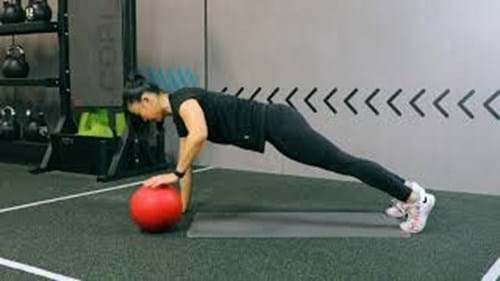Medicine Ball Push Ups
What Is A Medicine Ball Push Up?

Medicine ball press ups, also known as medicine ball push ups and medicine ball walkovers, are a variation of the traditional push up exercise that involves balancing on a medicine ball.
Rather than keeping both hands pressed into the floor, you'll instead place one onto the medicine ball, which is a type of weighted ball often used for strength training and rehabilitation. This adds a level of instability to the push up, which means you'll engage more stabiliser muscles, particularly in the shoulders and core.
This is a fairly challenging level of press up, so if you're completely new to the movement it could be worth starting with modified (knee) push ups, before moving on to regular press ups. Once you're comfortable with those, then you can work different variations into your workout schedules.
Combine medicine ball press ups with other advanced options like pike push ups, diamond push ups, decline press ups, one arm push ups or archer push ups for a varied workout that challenges a range of muscles in your body.
Check out some other push up variations: diamond press ups, spiderman push ups, pike push ups, one arm push ups
Commonly Asked Questions On Medicine Ball Push Ups
Medicine ball press ups offer several benefits and work various muscle groups. In addition to building upper body strength, some of the benefits of this press up variation include increased core activation, improved shoulder stability, and better coordination and balance.
Increased core activation: By placing one hand on the medicine ball, you're creating an unstable foundation for the push up. This means you'll need to actively engage your core muscles to maintain balance.
Enhanced upper body strength: Like traditional push ups, medicine ball press ups primarily target the chest, shoulders, and triceps, promoting upper body strength and endurance.
Improved stabilisation: This style of movement forces the stabiliser muscles in the shoulders and core to work harder to control the body during the exercise.
Functional strength: Medicine ball press ups simulate real-life movements where stability and strength are required on one side of the body at a time, making it a functional exercise.
Coordination and balance: The need to shift your weight and alternate hands on the medicine ball challenges your coordination and balance, promoting overall body awareness.
Medicine ball press ups primarily focus on the upper body - here are the key muscles worked: • Chest (pectoralis major): The chest muscles are heavily engaged during the pushing phase of the press up. • Shoulders (deltoids): Both the anterior (front) and lateral (side) deltoids are involved, especially during the transition between hands. • Triceps brachii: The back of the arms, or triceps, are activated as you extend your elbows during the push up. • Core muscles: The entire core, including the rectus abdominis, obliques, and transverse abdominis, is actively engaged to stabilise the body. • Serratus anterior: This muscle, located on the sides of the chest, is involved in the stability and control of the shoulder blades. • Scapular stabilisers: Muscles that control the movement and stability of the shoulder blades, such as the rhomboids and trapezius, are worked to maintain proper shoulder positioning.
Medicine ball push ups are more challenging than regular push ups. They place more demand on the stabilising muscles in the chest, shoulders, and core, which can make them more effective at building a stronger, more stable upper body. We’d advise mastering normal push ups before attempting medicine ball push ups.
Medicine Ball Press Up Tips
Place your hands slightly wider than shoulder-width apart on the floor to ensure stability.
Keep your core muscles tight throughout the exercise. This will help stabilise your body and prevent excessive movement.
Maintain a straight line with your body, from your head to your heels. Avoid letting your hips sag or pike upward.
Perform the press ups with controlled and deliberate movements. Avoid rushing through the exercise to ensure proper muscle engagement and reduce the risk of injury.
Ensure that your hand is centred on the medicine ball and that your fingers are spread for a secure grip. This will help you maintain stability.
How To Do Medicine Ball Press Ups
Start in a plank position with the medicine ball on the floor to the right of your right hand.
Lift your right hand and place it on the medicine ball whilst keeping the rest of your body as still as you can.
Bring the medicine ball closer if needed. From this position, perform a press up by slowly bending your elbows and lowering your body, whilst shifting your body to your right hand.
Push back up to the starting position and roll the ball over to your left arm. Repeat on the left side.
If you’re not sure if any of the above exercises are suitable for you, please consult your doctor before you start it. Need guidance on how to perform the exercise? Ask a personal trainer at your gym.